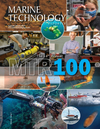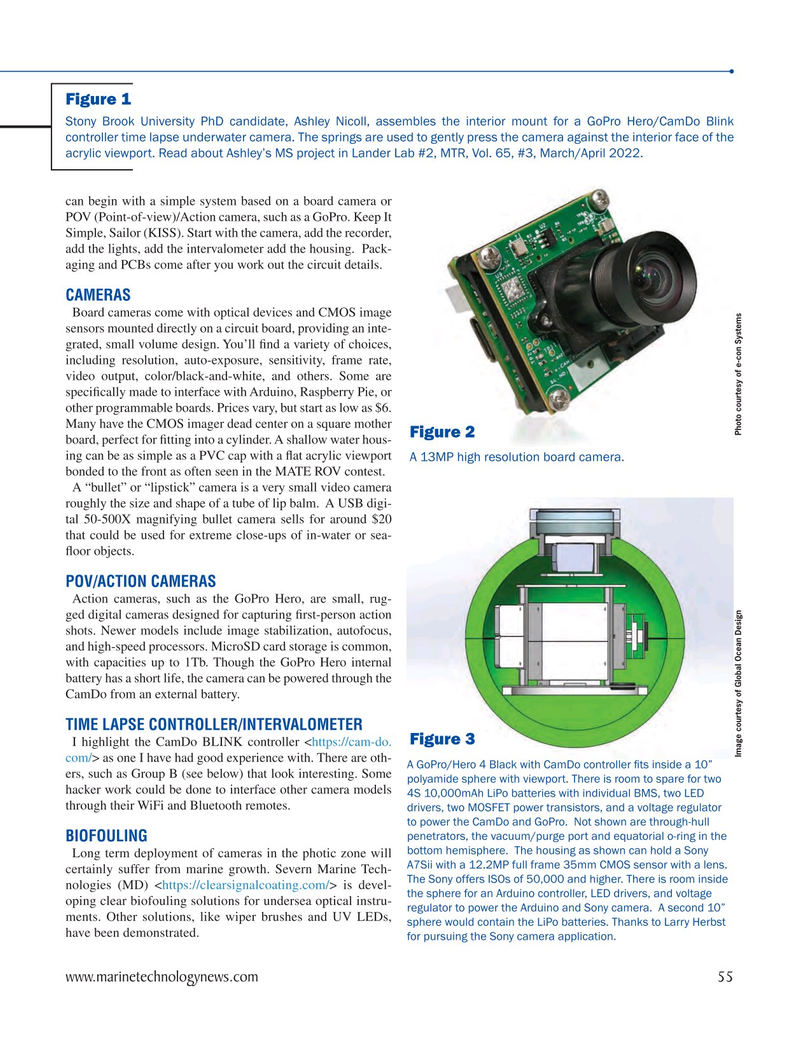
Page 55: of Marine Technology Magazine (September 2023)
Read this page in Pdf, Flash or Html5 edition of September 2023 Marine Technology Magazine
Figure 1
Stony Brook University PhD candidate, Ashley Nicoll, assembles the interior mount for a GoPro Hero/CamDo Blink controller time lapse underwater camera. The springs are used to gently press the camera against the interior face of the acrylic viewport. Read about Ashley’s MS project in Lander Lab #2, MTR, Vol. 65, #3, March/April 2022. can begin with a simple system based on a board camera or
POV (Point-of-view)/Action camera, such as a GoPro. Keep It
Simple, Sailor (KISS). Start with the camera, add the recorder, add the lights, add the intervalometer add the housing. Pack- aging and PCBs come after you work out the circuit details.
CAMERAS
Board cameras come with optical devices and CMOS image sensors mounted directly on a circuit board, providing an inte- grated, small volume design. You’ll ? nd a variety of choices, including resolution, auto-exposure, sensitivity, frame rate, video output, color/black-and-white, and others. Some are speci? cally made to interface with Arduino, Raspberry Pie, or other programmable boards. Prices vary, but start as low as $6.
Many have the CMOS imager dead center on a square mother
Figure 2 board, perfect for ? tting into a cylinder. A shallow water hous- ing can be as simple as a PVC cap with a ? at acrylic viewport
A 13MP high resolution board camera. bonded to the front as often seen in the MATE ROV contest.
A “bullet” or “lipstick” camera is a very small video camera roughly the size and shape of a tube of lip balm. A USB digi- tal 50-500X magnifying bullet camera sells for around $20 that could be used for extreme close-ups of in-water or sea- ? oor objects.
POV/ACTION CAMERAS
Action cameras, such as the GoPro Hero, are small, rug- ged digital cameras designed for capturing ? rst-person action shots. Newer models include image stabilization, autofocus, and high-speed processors. MicroSD card storage is common, with capacities up to 1Tb. Though the GoPro Hero internal battery has a short life, the camera can be powered through the
CamDo from an external battery.
TIME LAPSE CONTROLLER/INTERVALOMETER
Figure 3
I highlight the CamDo BLINK controller Image courtesy of Global Ocean Design Photo courtesy of e-con Systems com/> as one I have had good experience with. There are oth- A GoPro/Hero 4 Black with CamDo controller ? ts inside a 10” ers, such as Group B (see below) that look interesting. Some polyamide sphere with viewport. There is room to spare for two hacker work could be done to interface other camera models 4S 10,000mAh LiPo batteries with individual BMS, two LED through their WiFi and Bluetooth remotes. drivers, two MOSFET power transistors, and a voltage regulator to power the CamDo and GoPro. Not shown are through-hull penetrators, the vacuum/purge port and equatorial o-ring in the BIOFOULING bottom hemisphere. The housing as shown can hold a Sony Long term deployment of cameras in the photic zone will A7Sii with a 12.2MP full frame 35mm CMOS sensor with a lens. certainly suffer from marine growth. Severn Marine Tech- The Sony offers ISOs of 50,000 and higher. There is room inside nologies (MD) for pursuing the Sony camera application. www.marinetechnologynews.com 55 MTR #7 (50-65).indd 55 10/2/2023 3:36:39 PM

 54
54

 56
56
